Contents
- 1 Garden Essentials Every Green Thumb Needs
- 2 Our Top Ten Picks
- 3 1. The All-Purpose Garden Trowel: Garden Guru Transplanter Trowel Shovel
- 4 2. Pruning Shears: Snip with Precision: Fiskars Garden Pruning Shears
- 5 3. A Sturdy Garden Spade: For the Heavy Lifters – Emsco Group 1257-1 Workforce Tools Spade
- 6 4. Rakes and Hoes: Tame Your Plot with Ease – Suchtale Stirrup Hoe and 5-Tines Rake
- 7 5. A Solid Hose: Hydration is Key – 50 ft Expandable Garden Hose
- 8 6. Wheelbarrow: A Gardener’s Best Friend – Gorilla Carts Poly Garden Dump Cart
- 9 7. Gloves: Protect Your Hands, Enhance Your Grip – Nimalpal 6 Pairs Gardening Gloves
- 10 8. Garden Knife: An Invaluable Multipurpose Tool – PERWIN Hori Hori Garden Knife
- 11 9. Secateurs: Make Each Cut Count – Fiskars Secateurs SmartFit Pruner Bypass
- 12 10. Planting and Soil Scoops: Essential for Transplanting – Fiskars Fiber Composite Soil Scoop
- 13 Frequently Asked Questions (FAQs): Cultivating Your Knowledge
- 14 Author
Garden Essentials Every Green Thumb Needs
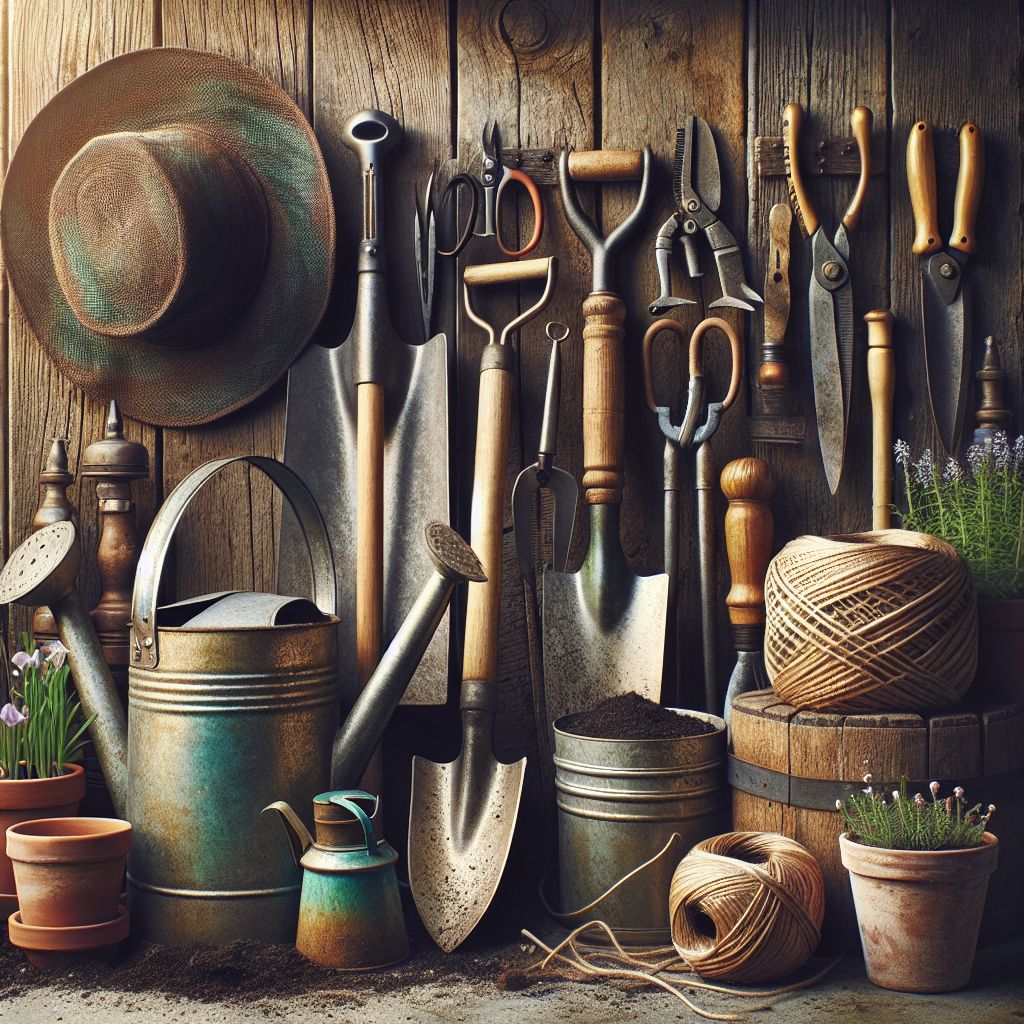
Whether you’re nurturing a modest balcony container garden or overseeing an expansive backyard plot, having the right tools in your shed can transform gardening from a chore into a cherished hobby. I’m here to walk you through the 10 essential tools that every gardener should have on hand. These tools will not only make your work easier but also help your garden thrive.
Why High-Quality Tools Matter in Gardening
Imagine trying to slice a ripe tomato with a dull knife, frustrating right? The same goes for gardening; the right tools make all the difference. High-quality gardening tools can withstand the rigors of digging, pruning, and planting. They’re designed to be comfortable to hold, reducing the strain on your hands and back. Moreover, they last longer, saving you money in the long run.
Our Top Ten Picks
-
Best Garden Trowel: Garden Guru Transplanter Trowel Shovel
-
Pruning Shears: Fiskars Garden Pruning Shears
-
Garden Spade: Emsco Group 1257-1 Workforce Tools Spade
-
Rakes and Hoes: Suchtale Stirrup Hoe and 5-Tines Rake
-
Solid Hose: 50 ft Expandable Garden Hose
-
Wheelbarrow: Gorilla Carts Poly Garden Dump Cart
-
Garden Knife: PERWIN Hori Hori Garden Knife
-
Secateurs: Fiskars Secateurs SmartFit Pruner Bypass
-
Soil Scoops: Fiskars Fiber Composite Soil Scoop
1. The All-Purpose Garden Trowel: Garden Guru Transplanter Trowel Shovel
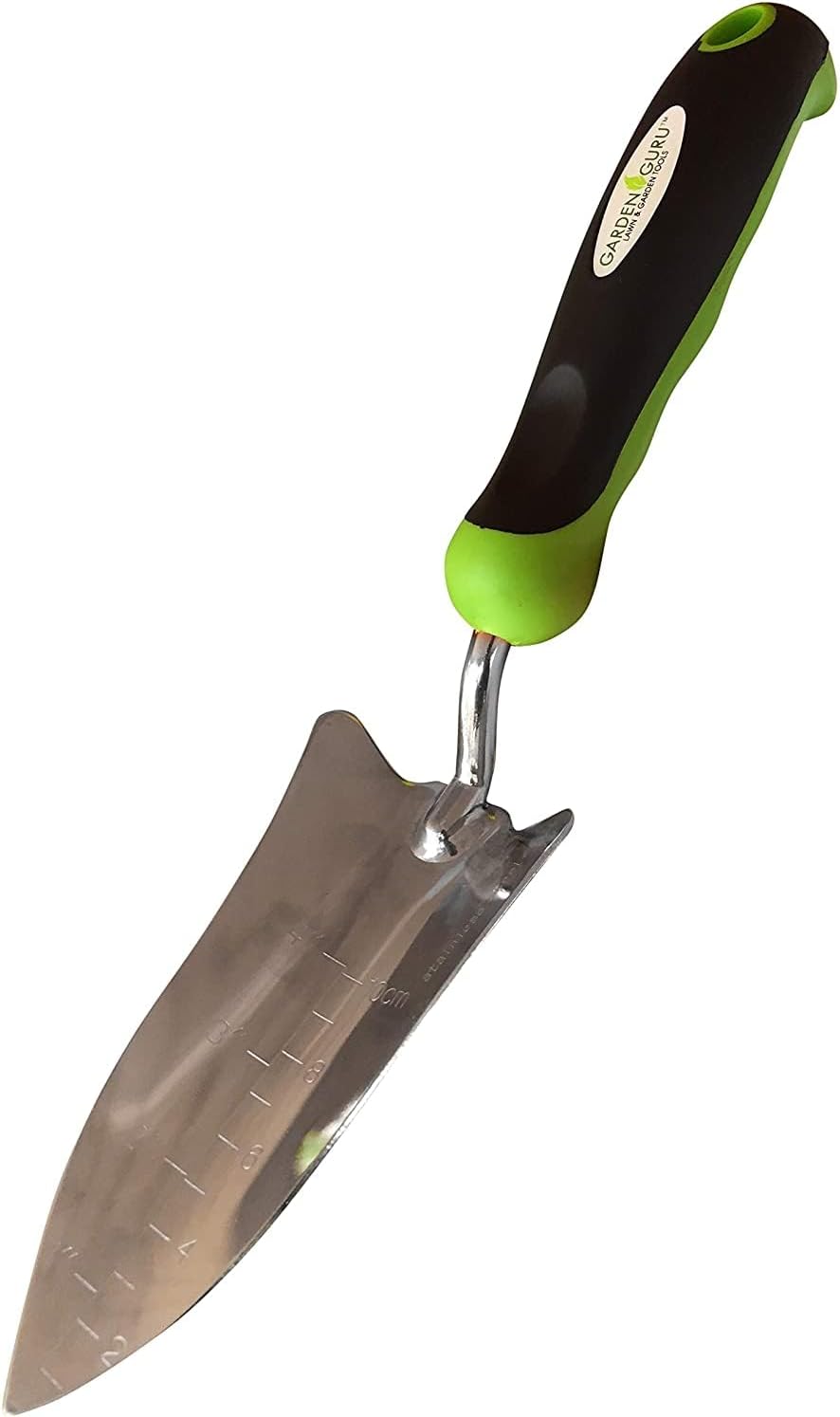
Let’s dig in with the garden trowel, arguably the most versatile and indispensable tool in a gardener’s arsenal. From digging holes for planting to weeding around your prized roses, a sturdy trowel can handle it all. Its pointed blade easily cuts through the soil, while the handle provides leverage to pry up stubborn roots and rocks.
Choosing the Right Trowel for Your Soil Type
When selecting a trowel, consider the type of soil in your garden. A heavy-duty, stainless steel blade is ideal for working in clay or rocky soil, while a lighter, aluminum blade may be more suitable for sandy or loamy soil. The key is to find one that feels comfortable in your hand and can tackle your garden’s unique challenges.
For example, if you’re dealing with heavy clay soil, you’ll want a trowel with a robust handle that won’t snap under pressure. On the other hand, if your garden bed is fluffy and light, a trowel with a longer, narrower blade can help you plant delicate seedlings with precision.
Top Trowel Brands to Consider
• Wilcox All-Pro Trowels – known for their nearly indestructible stainless steel construction.
• Fiskars Big Grip Trowel – features a comfortable, oversized handle and a sharp, rust-resistant blade.
• Nisaku Hori-Hori Weeding & Digging Knife – a Japanese tool that combines a trowel’s functionality with a slicing blade.
Choosing one of these top-tier brands means investing in a tool that will stand up to the test of time and the elements.
2. Pruning Shears: Snip with Precision: Fiskars Garden Pruning Shears
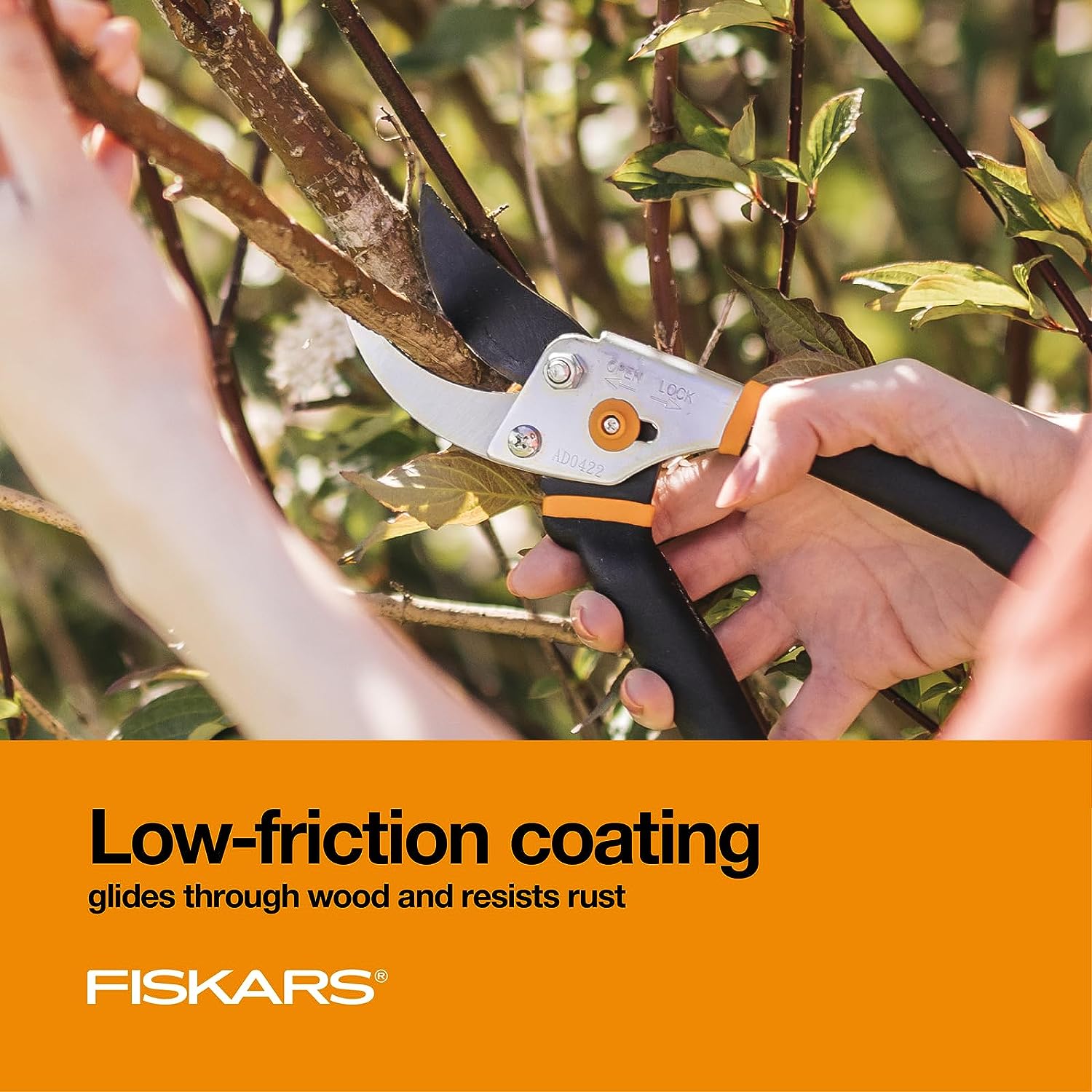
The Best Shears for Delicate Pruning Jobs
Pruning shears are the gardener’s scalpel. They are crucial for shaping plants, deadheading flowers, and cutting back overgrown foliage. But not all shears are created equal. The best shears for delicate jobs will be lightweight, sharp, and comfortable to hold. They allow for precision work without damaging the plants or causing hand fatigue.
Most importantly, look for shears with bypass blades—these act like scissors and make clean cuts that heal quickly. Avoid anvil-style shears for delicate jobs; they can crush plant stems. A good pair of pruning shears makes all the difference in keeping your garden healthy and looking its best.
Features to Look for in Pruning Shears
When selecting pruning shears, consider these features:
• Blade Material: High-carbon steel blades stay sharp longer and resist rust.
• Handle Comfort: Ergonomic handles reduce strain on your hands.
• Size: Shears should fit comfortably in your hand; not too big or too small.
• Safety Lock: A must-have feature to keep the blades closed when not in use.
Brands like Felco and ARS are often recommended by seasoned gardeners for their reliability and quality. Investing in a good pair of shears means you won’t be replacing them every season, and your garden will thank you for the precise cuts.
3. A Sturdy Garden Spade: For the Heavy Lifters – Emsco Group 1257-1 Workforce Tools Spade
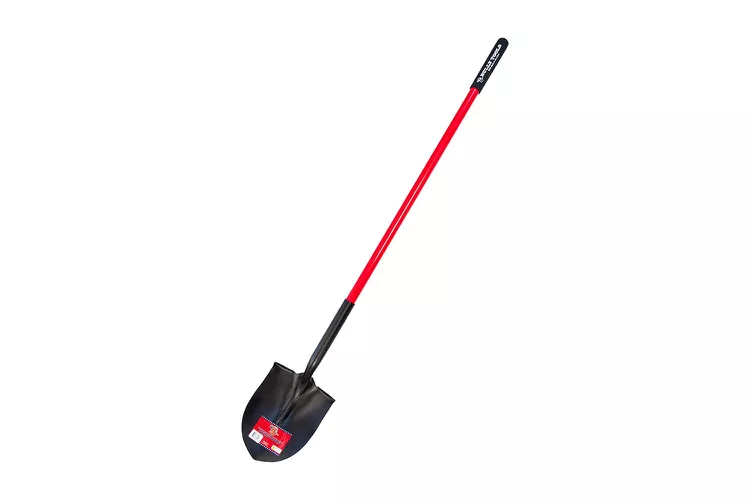
A garden spade is essential for digging, edging, and lifting sod. It’s the workhorse tool for any gardener looking to create new beds or plant shrubs. A spade with a sharp edge and a comfortable handle will make cutting into the soil almost effortless.
Advantages of a Reliable Spade
A reliable spade offers numerous advantages:
• Its flat, straight edge is perfect for creating sharp borders around garden beds.
• The sturdy handle allows for leverage when digging into tough soil.
• A well-made spade can also double as a chopping tool for dividing perennials.
For gardeners dealing with rocky or hard soil, a spade with a steel head and a fiberglass handle can provide the necessary strength without the added weight of traditional wood-handled tools.
Spade Maintenance for Longevity
Proper maintenance is key to extending the life of your spade:
• Clean off soil after each use to prevent rust.
• Sharpen the blade periodically to maintain a clean cutting edge.
• Oil the handle if it’s made of wood to keep it from drying out and cracking.
With these simple steps, your spade can last for many gardening seasons to come.
4. Rakes and Hoes: Tame Your Plot with Ease – Suchtale Stirrup Hoe and 5-Tines Rake

Rakes and hoes are indispensable for keeping the garden tidy and the soil in good condition. They help you clear debris, level soil, and uproot weeds. While they may seem like straightforward tools, there’s a variety to choose from, each suited to different tasks.
Rake Types for Different Garden Needs
Consider the following rake types for your garden needs:
• Leaf Rake: With its flexible, fan-shaped head, it’s perfect for clearing leaves and light debris.
• Garden Rake: This has a solid head with rigid tines, ideal for breaking up soil clumps and leveling beds.
• Shrub Rake: Its narrow head allows you to reach into tight spaces between plants.
Choose a rake with a comfortable handle length to avoid stooping, and look for durable construction to handle the rigors of garden work.
Hoe Selection for Efficient Weeding and Cultivating
When it comes to hoes, the right choice can save you time and effort:
• Dutch Hoe: Push it just beneath the soil surface to slice through weed roots.
• Warren Hoe: Its pointed tip is great for making seed furrows.
• Stirrup Hoe: Also known as a hula hoe, it uses a back-and-forth motion to cut weeds just below the surface.
Look for a hoe with a sharp blade and a comfortable handle to make weeding less of a chore and more of a quick routine task.
5. A Solid Hose: Hydration is Key – 50 ft Expandable Garden Hose

Every plant needs water, but not all watering methods are created equal. The key to a flourishing garden is consistent and appropriate hydration, which can be achieved through either a watering can or a hose, depending on the size of your garden and your personal preference.
Hose: Balancing Convenience and Necessity
Hoses provide an efficient way to cover large areas quickly. But it’s not just about coverage; the type of nozzle on your hose can dramatically affect the water flow and pressure, allowing for gentle showers or a more concentrated stream.
• Opt for a hose with adjustable nozzles to cater to different plants’ needs, from a fine mist to a steady stream.
• Consider soaker hoses or drip irrigation systems for water conservation and deep, root-level watering.
Remember, the goal is to water the roots, not the leaves, which can lead to fungal diseases in some plants.
Moreover, watering at the right time of day—early morning or late afternoon—can minimize evaporation and ensure that your plants get the hydration they need to thrive.
Understanding Watering Requirements for Various Plants
Not all plants thirst the same. Some, like succulents and cacti, prefer a dry spell between drinks, while others, such as lettuce and celery, need consistent moisture. That’s why it’s important to understand the specific needs of each plant in your garden.
To avoid over or under-watering, stick your finger about an inch into the soil. If it’s dry, it’s time to water; if it’s still moist, you can wait another day. And always water deeply to encourage strong root growth.
Consistency is key. Plants thrive on routine, so try to water at the same time each day. This not only helps the plants but also makes it easier for you to integrate gardening into your daily schedule.
6. Wheelbarrow: A Gardener’s Best Friend – Gorilla Carts Poly Garden Dump Cart

Whether you’re moving soil, compost, or harvests, a wheelbarrow is an indispensable tool for any gardener. It saves you from the back-breaking work of carrying heavy loads and makes it easy to transport materials across your garden.
Investing in a sturdy wheelbarrow can make all the difference in your gardening efficiency. Look for one with a durable construction and an ergonomic design that makes it easy to maneuver, even when fully loaded.
Why Wheelbarrows Are Essential for Large Gardens
For those with larger gardens, a wheelbarrow is not just a convenience; it’s a necessity. It allows you to carry out tasks such as spreading mulch or moving plants without multiple trips back and forth. This can save you a tremendous amount of time and energy over the course of the gardening season.
Finding a Wheelbarrow that’s Easy on Your Back
When choosing a wheelbarrow, consider the following:
• The number of wheels: Single-wheel models are more maneuverable, while two-wheel models offer more stability.
• Material: Plastic wheelbarrows are lightweight and easy to clean, whereas metal ones are more durable and can handle heavier loads.
• Handles: Look for ergonomically designed handles that provide a comfortable grip and reduce strain on your arms and back.
Remember, a good wheelbarrow is an investment that will pay off in the long run by making your gardening work much easier.
7. Gloves: Protect Your Hands, Enhance Your Grip – Nimalpal 6 Pairs Gardening Gloves
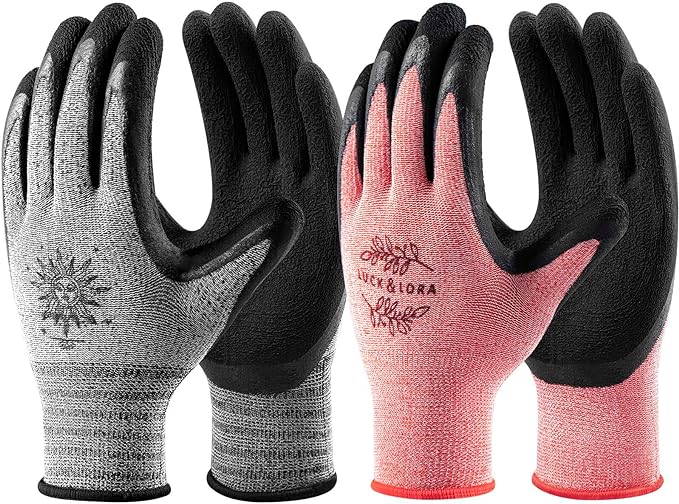
Protecting your hands is crucial in gardening. Gloves not only shield your skin from thorns and blisters but also improve your grip on tools. They come in various materials and styles, each suited to different tasks, from heavy-duty leather for pruning roses to lightweight cotton for sowing seeds.
Never underestimate the value of a good pair of gardening gloves. They can prevent scrapes, reduce fatigue, and even protect you from soil-borne bacteria and pesticides.
Choosing Gloves to Avoid Blisters and Cuts
When selecting gloves, look for these features:
• Durability: A tough material like leather or synthetic leather can prevent cuts and punctures.
• Fit: Gloves should be snug but not tight, allowing full range of motion for your fingers.
• Comfort: Breathable fabrics can prevent sweating, while padded palms can cushion against repetitive motions.
And don’t forget, gloves need care too. Clean them regularly and store them in a dry place to prevent mildew.
Durable Gloves for Every Gardening Task
For different gardening tasks, you might need more than one pair of gloves:
• Use leather gloves for heavy work like digging and pruning.
• Opt for rubber-coated gloves when dealing with wet soil or water plants.
• Choose gloves with reinforced fingertips for tasks that require dexterity, like planting seeds or transplanting seedlings.
With the right gloves, you can garden comfortably for hours, keeping your hands safe and your plants healthy.
8. Garden Knife: An Invaluable Multipurpose Tool – PERWIN Hori Hori Garden Knife

A garden knife, often called a Hori-Hori in Japan, is a tool that combines the functions of a knife, a trowel, and a saw. It’s incredibly useful for cutting through roots, transplanting, dividing perennials, and even opening bags of compost.
The serrated edge can saw through small branches, while the sharp, straight edge is perfect for slicing open soil bags. The concave blade scoops soil effectively, making it a handy tool for planting bulbs or digging out weeds.
Example: When transplanting a young tomato plant, use the garden knife’s serrated edge to loosen the plant from its container, then flip it to use the sharp edge to dig the perfect hole for planting.
The garden knife’s versatility makes it a must-have in any gardener’s tool belt.
The Versatility of a Garden Knife in Day-to-Day Tasks
Here’s how a garden knife can simplify your gardening routine:
• Dividing plants: The sharp blade can easily split perennials for propagation.
• Weeding: The pointed tip is ideal for uprooting weeds, especially those with deep roots.
• Planting: Use the measurement markings on the blade to plant seeds and bulbs at the correct depth.
With a garden knife, you’ll find yourself reaching for this one tool for a multitude of tasks, making it a true workhorse in the garden.
Most importantly, a high-quality garden knife should have a full tang blade that extends into the handle, ensuring strength and longevity.
Recommendations for High-Quality Garden Knives
Consider the Nisaku Hori-Hori Weeding & Digging Knife, renowned for its durable stainless steel blade and comfortable wooden handle. It’s a favorite among gardeners for its precision and resilience.
When choosing a garden knife, look for one with a comfortable grip and a blade made from high-quality materials like stainless steel or carbon steel to resist rust and wear.
9. Secateurs: Make Each Cut Count – Fiskars Secateurs SmartFit Pruner Bypass
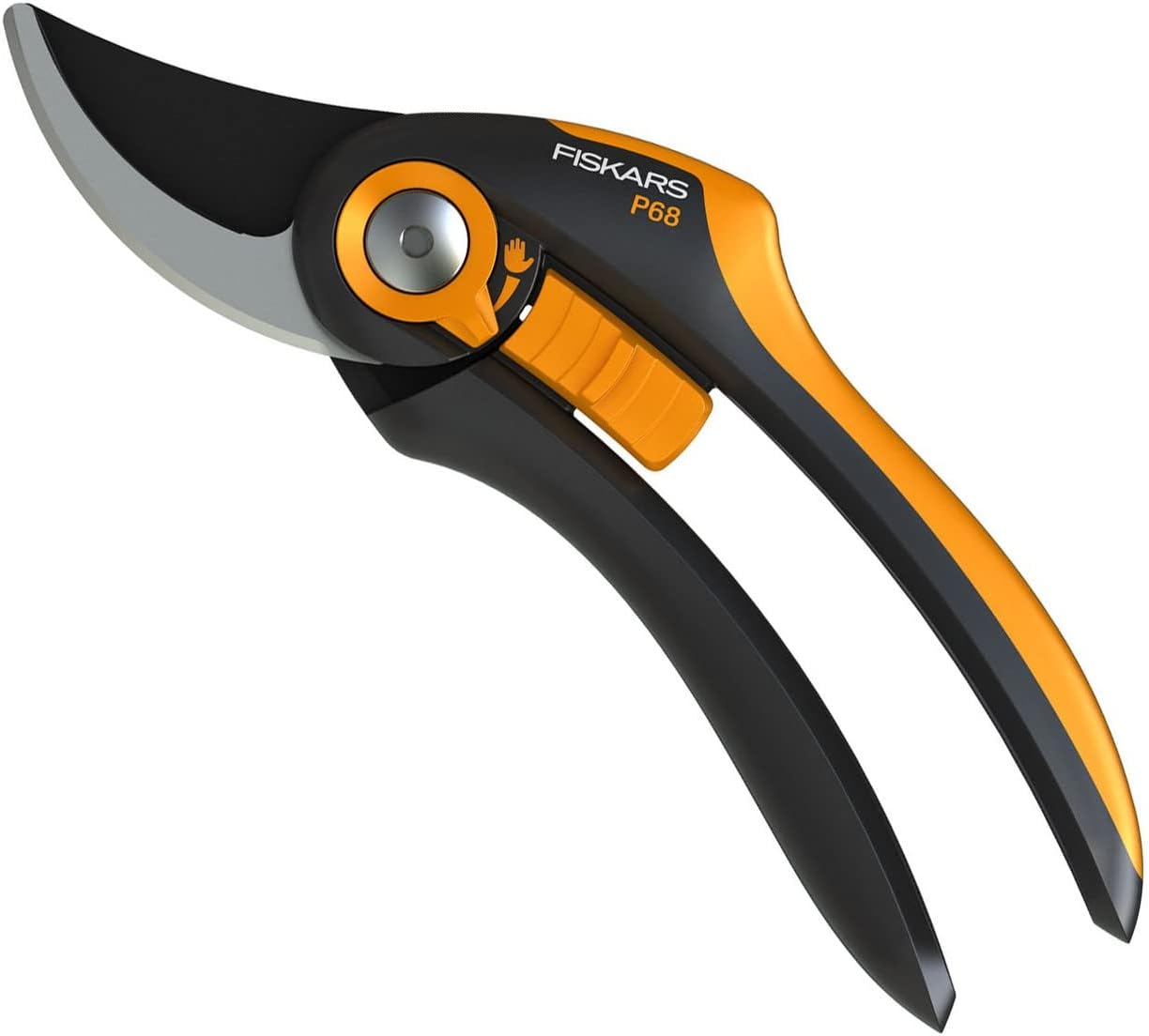
When it comes to shaping your plants and keeping them healthy, a pair of sharp secateurs is your best friend. These powerful pruners allow you to snip through stems and branches with precision, encouraging new growth and preventing disease.
Secateurs Vs. Shears: Understanding the Difference
Secateurs are designed for precision work and can handle thicker branches than shears. Shears are better for trimming hedges and cutting back perennials. Both are important, but for different reasons. Secateurs give you the control needed for careful, selective pruning.
Opting for Ergonomic Secateurs for Comfortable Use
Ergonomic secateurs reduce the strain on your hands, which is a real advantage during long pruning sessions. Look for models with rotating handles that move with the natural motion of your hands, and ratchet mechanisms that multiply your hand’s strength.
10. Planting and Soil Scoops: Essential for Transplanting – Fiskars Fiber Composite Soil Scoop
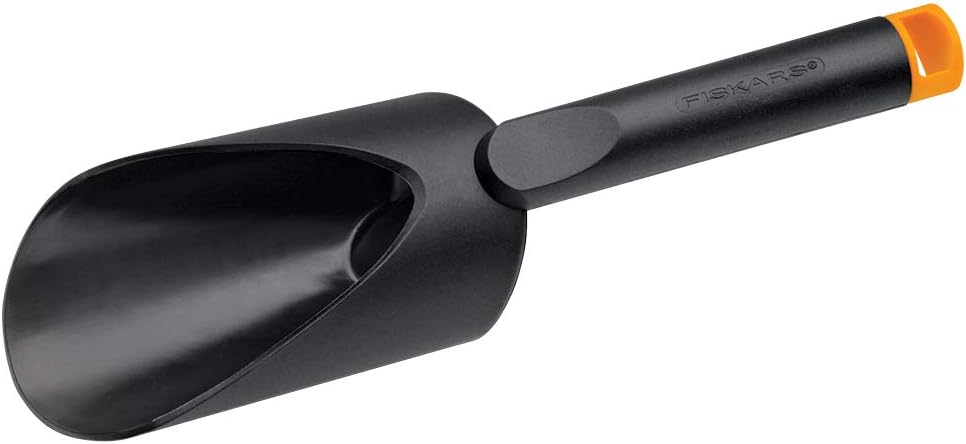
These specialized tools might not be as well-known as the trowel, but they’re just as important. Soil scoops have deep, curved bowls that make it easy to move soil, compost, or potting mix without spilling.
The Benefits of Specialized Scoops for Seedlings
When you’re transplanting seedlings, the gentle scoop of the soil scoop can lift the tender plants without damaging their roots. It’s a simple tool, but it makes a big difference when it comes to delicate transplanting work.
Investing in Scoops that Minimize Soil Spillage
A good scoop will have a comfortable handle and a bowl that’s wide enough to carry a substantial amount of soil but not so large that it becomes unwieldy. Look for one made from stainless steel for durability and ease of cleaning.
Frequently Asked Questions (FAQs): Cultivating Your Knowledge

Let’s address some common questions to round out your gardening knowledge.
What’s the Difference Between a Trowel and a Spade?
A trowel is small and handheld, perfect for planting and weeding in tight spaces, while a spade is larger and used for digging and moving soil on a bigger scale.
How Often Should I Sharpen My Garden Tools?
You should sharpen cutting tools like secateurs and shears at least once a season, or whenever you notice them becoming dull.
Can I Use Regular Household Gloves for Gardening?
While you can, gardening gloves are specially designed to protect against soil, moisture, and thorns, so they’re a better choice for serious gardeners.
When is the Best Time to Prune Plants?
Most plants should be pruned in late winter or early spring, but it varies by species, so do a bit of research on your specific plants.
What Should I Look for When Choosing a Hose?
Consider length, durability, and the type of nozzle. A kink-resistant hose with multiple spray settings is usually a good choice.
And there you have it, a toolkit that will empower you to create the garden of your dreams. Remember, gardening is a journey, and with these tools in hand, you’re well-equipped for the adventure. Happy gardening!



